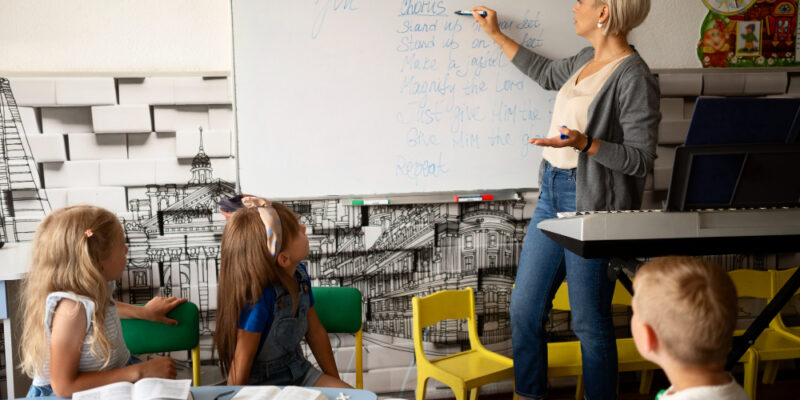
Microteaching lessons are an essential component of teacher training programs, providing aspiring educators with the opportunity to practice their instructional skills in a controlled and supportive environment. However, even in these simulated settings, effective classroom management is crucial for ensuring a smooth and productive learning experience. In this article, we’ll explore various classroom management techniques specifically tailored for microteaching lessons, helping you cultivate an engaging and positive learning atmosphere.
Understanding Microteaching Lesson Plans
Before delving into classroom management strategies, it’s important to understand the concept of a microteaching lesson plan. A microteaching lesson plan is a meticulously designed outline that guides the structure and flow of a microteaching session. It typically includes elements such as learning objectives, instructional activities, assessment methods, and time allocations.
By carefully crafting a well-structured microteaching lesson plan, you can anticipate potential challenges and proactively implement classroom management techniques to address them. A thoughtful lesson plan not only ensures a cohesive learning experience but also helps you maintain control and maintain a positive learning environment.
Establishing Classroom Routines and Procedures
One of the most effective classroom management techniques for microteaching lessons is establishing clear routines and procedures from the outset. Even in a simulated setting, consistent routines can help create a sense of predictability and structure, which aids in maintaining focus and minimizing disruptions.
Begin by outlining your expectations for behaviour, participation, and classroom protocols. Clearly communicate these expectations to your peers or simulated students, and consistently reinforce them throughout the microteaching session. This approach not only sets the tone for the lesson but also helps you maintain a sense of control and authority.
Promoting Active Engagement
Active engagement is key to creating a productive and engaging learning environment during microteaching lessons. By involving your peers or simulated students in the learning process, you can foster a sense of investment and accountability, which can significantly contribute to effective classroom management.
Incorporate interactive instructional strategies, such as think-pair-share activities, group discussions, or hands-on exercises. These techniques not only promote active participation but also provide opportunities for you to monitor and redirect student behaviour as needed.
Effective Questioning and Wait Time
Thoughtful questioning techniques can be a powerful classroom management tool during microteaching lessons. By posing well-crafted questions and allowing adequate wait time, you can encourage active participation, promote critical thinking, and maintain student engagement.
Practice using a variety of questioning strategies, such as open-ended questions, probing questions, and follow-up questions. Additionally, incorporate appropriate wait time, allowing your peers or simulated students sufficient time to formulate their responses. This approach not only fosters deeper learning but also helps maintain a focused and attentive classroom environment.
Positive Reinforcement and Feedback
Positive reinforcement and constructive feedback can be invaluable classroom management techniques during microteaching lessons. By acknowledging and praising desirable behaviours, you can reinforce positive conduct while simultaneously addressing and redirecting any disruptive or off-task behaviours.
Make a conscious effort to provide specific, timely, and constructive feedback to your peers or simulated students. Celebrate their achievements, no matter how small, and offer guidance and support when needed. This approach not only encourages engagement and motivation but also helps create a respectful and supportive learning environment.
Nonverbal Cues and Proximity
Nonverbal cues and purposeful use of proximity can be powerful classroom management tools during microteaching lessons. By being mindful of your body language, facial expressions, and physical positioning within the learning space, you can effectively communicate expectations and manage student behaviour without disrupting the flow of the lesson.
Practice using nonverbal cues, such as eye contact, gestures, and strategic movement around the classroom. These techniques can help you maintain focus, redirect attention, and reinforce positive behaviours without verbal interruptions.
In addition to these classroom management techniques, aspiring educators can also benefit from exploring tools like Managing Staff with School Management System, which can help streamline administrative tasks and foster better communication and collaboration among staff members, ultimately contributing to a more organized and efficient learning environment.
Conclusion
Effective classroom management is an essential component of successful microteaching lessons. By implementing strategies such as establishing clear routines and procedures, promoting active engagement, employing effective questioning techniques, providing positive reinforcement and feedback, and utilizing nonverbal cues and proximity, you can create a conducive learning environment that fosters engagement, focus, and productivity.
Remember, microteaching lessons are a valuable opportunity to hone your classroom management skills in a supportive setting. Embrace these techniques, seek feedback from your instructors and peers, and continually refine your approach. With practice and dedication, you’ll develop the confidence and expertise necessary to effectively manage a classroom and create a positive learning experience for your future students.
What is the purpose of a microteaching lesson plan?
A microteaching lesson plan serves as a detailed outline for a microteaching session. It helps aspiring teachers structure their lessons, identify learning objectives, plan instructional activities, and allocate time effectively. A well-designed lesson plan is crucial for maintaining control and creating a productive learning environment during microteaching sessions.
How can active engagement contribute to effective classroom management?
Active engagement is a powerful classroom management technique because it promotes student investment and accountability. By involving peers or simulated students in interactive instructional strategies, such as group discussions, hands-on exercises, or think-pair-share activities, you can maintain their focus and minimize disruptive behaviors.
What role do nonverbal cues and proximity play in classroom management during microteaching lessons?
Nonverbal cues and purposeful use of proximity can be invaluable classroom management tools during microteaching lessons. By being mindful of your body language, facial expressions, and physical positioning within the learning space, you can effectively communicate expectations and manage student behaviour without disrupting the flow of the lesson.
How can positive reinforcement and feedback contribute to effective classroom management?
Positive reinforcement and constructive feedback can help create a respectful and supportive learning environment during microteaching lessons. By acknowledging and praising desirable behaviours, you can reinforce positive conduct while simultaneously addressing and redirecting any disruptive or off-task behaviours. Timely and specific feedback can also encourage engagement and motivation.
Why is it important to practice classroom management techniques during microteaching lessons?
Microteaching lessons provide a controlled and supportive environment for aspiring teachers to practice and refine their classroom management skills. By implementing effective techniques during these simulated sessions, you can develop the confidence and expertise necessary to effectively manage a real classroom and create a positive learning experience for your future students.







